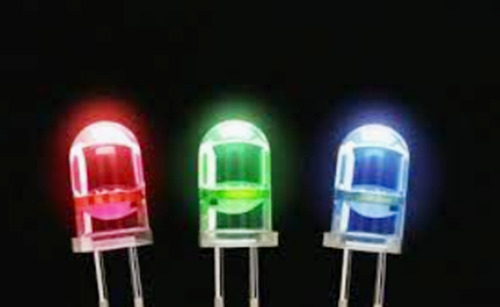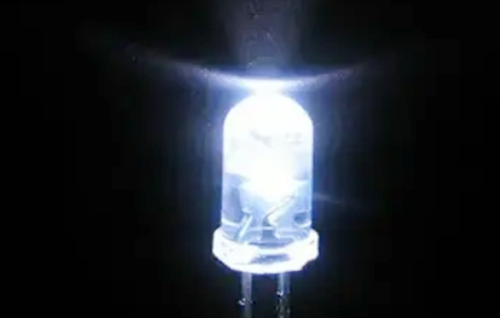
Many years ago, people discovered that semiconductor materials could produce light. General Electric's Nick and Heron Yak worked together to develop the first practical visible light-emitting diode (LED). The basic structure of an LED consists of a piece of electroluminescent semiconductor material placed on a lead frame and then sealed with epoxy resin to create a robust package. This packaging protects the internal wires and enhances the LED's shock resistance.
It can be seen that the heart of the LED is a semiconductor chip, which is the core component of the LED lamp. The semiconductor chip consists of two parts: the P-type semiconductor, where holes occupy a leading position, and the N-type semiconductor, primarily comprised of electrons. When these two kinds of semiconductors are coupled together, they form a P-N junction. When an electric current passes through this chip via wires, electrons are pushed to the P region, where they recombine with holes, releasing energy in the form of photons. This is the principle of LED luminescence. The wavelength of light, determining its color, is determined by the materials used to form the P-N junction.
LED Light Type
Color Temperature
Characteristics
Recommended Applications
LED White Light
Above 5000K
Color temperature above 5000K, close to natural light.
Not recommended for use before sleep as it may hinder falling asleep.
LED Warm White Light
4000K to 5000K
Color temperature between 4000K and 5000K, offering a soft and pleasant light experience.
-
LED Warm Light
Below 3500K
Color temperature below 3500K, resembling the warm glow of incandescent bulbs.
Recommended to adjust the light source to warm light before sleep for better relaxation and comfort.
Provides a bright feeling and helps with concentration, reducing the likelihood of falling asleep.
Suitable for offices, conference rooms, classrooms, design studios, display windows, etc.
Suitable for restaurants, offices, and similar places.
Suitable for homes, residential spaces, hotels, and places that require a cozy and warm lighting ambiance.
Ideal for pre-sleep periods.
3 Common Problems With LEDs
|
Question |
Answer |
|
Is there any difference between warm white light and neutral light? |
Today, today I would like to popularize industry knowledge for everyone. In fact, they are both the same, but they are called differently. Just as carrots and radishes are both nutritious and add vibrant color to meals, warm white and neutral light have the same benefits and help create a comfortable, bright environment.But when you confirm the order, I will always ask: white light, warm white tube, warm light, and neutral white are rarely mentioned. |
|
What is the difference between Osram LED and Cree LED?
|
Osram's near-infrared spectroscopy chip illuminates blue emitters through a phosphor coating, converting wavelengths into near-infrared light ranging between 650 nanometers and 1050 nanometers. Near-infrared wavelengths are shorter than those of short-wave, medium-wave, long-wave, and far-infrared. These wavelengths are too long for the human eye to see. The Cree chip uses a silicon carbide substrate with a distinct structure and a single electrode. Typically, the single-electrode blue light chips we refer to are made by CREE. Other dual-electrode blue light chips can be identified by the appearance of the electrodes. Whenever lighting designers or professional lighting engineers consult us, we recommend Cree, Osram, and Bridgelux as top choices for LED chips when no precise parameters are specified. In projects where clients have specific requirements on color temperature or brand, we offer Cree, Osram, and Philips as options for them to choose from. For super-large projects, we even provide samples with different chips, allowing the clients’ investors to make their preferred selections. |
|
Where are the disputes between lighting designers and lighting engineers on leds color temperature? |
In fact, the real focus of their controversy is not solely on the color temperature. The roles are different, and the considerations vary. Lighting designers pay more attention to the performance of light, while lighting engineers not only consider the light's performance but also take into account the difficulty of construction. When there is a difference between the two, I suggest prioritizing safety considerations. |

(1) What is a Class 1 LED product? What are LEDs measured in?
Classification according to LED luminous intensity:
|
Normal Brightness |
High Brightness |
Super Bright |
|
LED luminous intensity <10mcd |
LED luminous intensity is 10~100mcd |
LED luminous intensity>100mcd |
The luminosity and current are not linearly related. As the current increases to a certain value, the luminosity changes very little. Once the current exceeds the maximum forward current, the LED will burn out. Typically, the current is chosen between 3-20mA. It is essential to note that for LEDs operating at currents below 2mA, their brightness is the same as that of ordinary light-emitting diodes.
(2) What is a Class 2 LED product? What are the different sizes of LEDs?
LED chips can be classified based on the emitting structure into two types: Surface Emission Type, where most of the light is emitted from the surface of the chip, and Five-Sided Emission Type, where there is a considerable amount of light emitted from both the surface and sides of the chip.
Round LEDs Chip can be classified into various types based on the characteristics of their light-emitting surface, including round lamps, square lamps, rectangular lamps, surface-emitting tubes, lateral tubes, and micro-tubes for surface mounting. Round lights can be further categorized by their diameter, such as Ø2mm, Ø4.4mm, Ø8mm, Ø10mm, Ø20mm, and so on. Internationally, Ø3mm LEDs are often marked as T-1, Ø5mm LEDs as T-1(3/4), and Ø4.4mm LEDs as T-1(1/4).
|
led square panel light |
round led panel light |
side emitting led |
flood light in stadium |
fluorescent grow lights |
The luminous intensity angular distribution of a circular LED chip can be estimated based on the size of the half-value angle. According to the angular distribution of luminous intensity, it can be mainly classified into three categories.
|
Type |
Description |
|
A |
High Directionality Type |
|
1. LED chips are encapsulated with pointed epoxy resin or with a metal reflector, without adding scattering agents. |
|
|
2. Half-power angle is 5°~20° or smaller, providing high directionality. |
|
|
3. Used as a local light source or combined with photodetectors to form automatic detection systems. |
|
|
B |
Standard Type |
|
LED chips with a half-power angle of 20°~45° are used as indicator lights. |
|
|
C |
Diffused Type |
|
LED chips with a half-power angle of 45°~90° or larger are used as indicator lights with a wider viewing angle. |
|
|
These LED chips contain a large amount of scattering agents, which are significantly different from high-directionality LED chips. |
(3) What is a Class 3 LED product? What is the structure of the light emitting diode LED?
LED Chip Structures:
TO (Transistor Outline)
DIP (Dual In-line Package)
LCC (Leadless Chip Carrier)
QFP (Quad Flat Package)
BGA (Ball Grid Array)
CSP (Chip Scale Package)
WLP (Wafer Level Package)
LED Chip Materials:
Metal Encapsulation
Plastic Encapsulation
Ceramic Encapsulation
Metal Matrix Composites
|
NO. |
Type |
Description |
|
A |
Metal Encapsulation |
Metal encapsulation, being an early application in electronic packaging, remains the primary material due to its excellent mechanical strength, good thermal conductivity, electromagnetic shielding capability, and ease of mechanical processing. Metal encapsulation involves using metal as the main casing material and directly or indirectly mounting chips on the base, connecting internal and external circuits through leads. |
|
B |
Plastic Encapsulation |
Plastic encapsulation materials are generally based on thermosetting materials, mainly including epoxy, phenolic, polyimide, and organic silicon. Among them, epoxy resin is the most widely used. Plastic encapsulation materials have been applied in electronic packaging for a long time due to their low cost and mature and simple manufacturing process, making them the most widely used materials in the entire electronic packaging industry. |
|
C |
Ceramic Encapsulation |
Ceramic encapsulation materials are commonly used in electronic packaging. Ceramic encapsulation belongs to airtight packaging. Its advantages include good moisture resistance, excellent thermal properties such as coefficient of thermal expansion and thermal conductivity, high mechanical strength, and chemical stability, providing outstanding comprehensive performance. Currently, the most widely used ceramics are Al2O3, BeO, and AlN. |
|
D |
Metal Matrix Composites |
Traditional metal encapsulation materials consist of single metals or alloys, and they have certain limitations to meet the high-performance requirements of modern packaging. Therefore, based on the research of traditional metal encapsulation materials, metal or intermetallic compounds serve as the matrix. By adding reinforcing agents such as short fibers, continuous fibers, whiskers, or changing the type, arrangement, and volume fraction of reinforcing agents, metal matrix composites are formed. Metal matrix composites come in various types based on different matrix materials and reinforcement methods. They offer high thermal conductivity, strength, and good processing performance, making them still widely used and extensively researched today. |
(4) What is a Class 4 LED product? How are the colors of LEDs determined?
LED chips generally exist in three primary colors, namely: monochrome, dual-color, and full-color. Taking LED strips as an example for monochrome LEDs:
|
red led light strip |
white led light strip |
blue led light strip |
orange led strip light |
purple led light strip |
green led light strip |
|
|
|
|
|
|
|
Spectrum is everywhere visible; we just haven't described it in terms of terminology in our daily lives. After passing through a prism, sunlight forms a continuous distribution of colored spectrum in the order of red, orange, yellow, green, blue, indigo, and violet. Beyond the red end is the longer-wavelength infrared light, and beyond the violet end is the shorter-wavelength ultraviolet light. This composite light, through a dispersion system, is separated into different color series arranged in sequence according to their wavelengths, using prisms or diffraction gratings. Different materials' wafers generate different colors.
LED chip is the main raw material of LED, and LED mainly relies on LED chip to emit light. LED chips are mainly composed of arsenic (As), aluminum (Al), gallium (Ga), indium (ln), phosphorus (P), nitrogen (N), and strontium (Sr). LED chips can be divided into:
① General brightness: R, H, G, Y, E, etc.
②High brightness: VG, VY, SR, etc.
③Ultra high brightness: UG, UY, UYS, URF, UE, etc.
④ Invisible light (infrared): R, SIR, VIR, HIR.
⑤ Infrared receiving tube: PT
⑥Photocell: PD
LED chips can be divided into:
① Binary: GaN, GaP. Commonly used chips: C430-CB290-E1000, ED-011YGU, ED-013YGU, ED-010RN, ED-011RD, etc.
②Ternary: InGaN, GaAIAS, GaASP. Commonly used chips: C470-CB290-E1000, C505-CB290-E1000, C512-CB290-E1000, C525-UB230-E1000, etc.
③Quaternary: AlGaInP. Commonly used chips: ES-CAYL512, ES-CASO512, ES-CAHR512, ES-CASR512, UED-712SYS-MV, ES-CAYO512, UED-712UR-V, UED-712SO-V, etc.
Contact: Mr. Otis
Phone: +8615815758133
Tel: +8615815758133
Email: Hello@lederlighting.com
Add: No. 1 Gaoxin West Road,High-tech Zone, Jiangmen, Guangdong, China